
Varroa destructor, the Varroa mite, is an external parasitic mite that attacks and feeds on honey bees and is one of the most damaging honey bee pests in the world. A significant mite infestation leads to the death of a honey bee colony, usually in the late autumn through early spring. Without management for Varroa mite, honey bee colonies typically collapse within 2 to 3 years in temperate climates. These mites can infest Apis mellifera, the western honey bee, and Apis cerana, the Asian honey bee. Due to very similar physical characteristics, this species was thought to be the closely related Varroa jacobsoni prior to 2000, but they were found to be two separate species after DNA analysis.

Mason bee is a name now commonly used for species of bees in the genus Osmia, of the family Megachilidae. Mason bees are named for their habit of using mud or other "masonry" products in constructing their nests, which are made in naturally occurring gaps such as between cracks in stones or other small dark cavities. When available, some species preferentially use hollow stems or holes in wood made by wood-boring insects.

Osmia lignaria, commonly known as the orchard mason bee or blue orchard bee, is a megachilid bee that makes nests in natural holes and reeds, creating individual cells for its brood that are separated by mud dividers. Unlike carpenter bees, it cannot drill holes in wood. O. lignaria is a common species used for early spring fruit bloom in the United States and Canada, though a number of other Osmia species are cultured for use in pollination.

Osmia cornifrons, also known as the horned-face bee, is a species of solitary bee indigenous to Northern Asia. Physically, this species of bee is recognized for its horn-like extensions originating from its lower face. Populations of O. cornifrons have been recorded in multiple locations, including Japan, Korea, China, and Russia. O. cornifrons are more docile as compared to other species of bees and are less prone to sting when aggravated.

The Acaridae are a family of mites in order Sarcoptiformes.
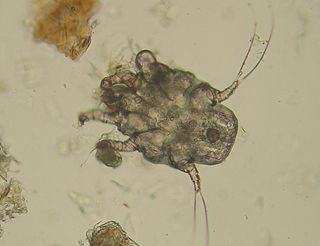
Astigmatina is a clade of mites in the order Sarcoptiformes. Astigmata has been ranked as an order or suborder in the past, but was lowered to the unranked clade Astigmatina of the clade Desmonomatides in the order. Astigmatina is now made up of the two groups Acaridia and Psoroptidia, which have been suborders of the order Astigmata in the past. Astigmatina contains about 10 superfamilies and 76 families under Acaridia and Psoroptidia.

Histiostomatidae is a family of mites in the clade Astigmata.
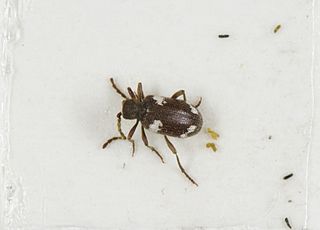
Ptinus sexpunctatus is a species of beetles in the genus Ptinus of the family Ptinidae. It is commonly known as the six-spotted spider beetle.

Rhizoglyphus is a genus of mites in the family Acaridae. It has a worldwide distribution and is often associated with the bulbs, corms or tubers of plants.
Schwiebea is a genus of mites in the family Acaridae. It is among the largest in the family with over 60 species.

Parasitellus is a genus of mites in the family Parasitidae which are obligatory parasites of bumblebees. These mites can be found clinging to the carapace, sometimes in large numbers. Mites in this genus hibernate in the deutonymphal stage. In the tritonymph stage they can actively transfer from bumblebee to bumblebee from flowers, where they can survive up to 24 hours. After they arrive in a bumblebee nest, they will moult into adults. Whilst it is not known what factors trigger the mite to molt, in laboratory conditions P. fucorum were found to moult after eating fresh pollen, although overall moulting success was low. They are kleptoparasitic or neutral to beneficial, depending on life stage; females and deutonymphs feed on provisioned pollen, while other stages are predators of small arthropods.

Phoresis or phoresy is a temporary commensalistic relationship when an organism attaches itself to a host organism solely for travel. It has been seen in ticks and mites since the 18th century, and in fossils 320 million years old. It is not restricted to arthropods or animals; plants with seeds that disperse by attaching themselves to animals are also considered to be phoretic.
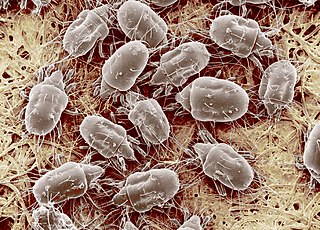
Tyrophagus putrescentiae is a cosmopolitan mite species. Together with the related species T. longior, it is commonly referred to as the mould mite or the cheese mite. The genus name translates from Greek to "cheese eater."
Lardoglyphus zacheri is a species of mite first discovered by Friedrich Zacher in a dermestid beetle culture. The genus Lardoglyphus was erected by Anthonie Cornelis Oudemans in 1927. The species is known to be a pest to institutional and private dermestid beetle colonies.
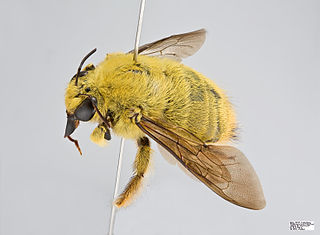
Xylocopa caffra is a species of Afrotropical carpenter bee that ranges from west to central and southern Africa, besides Madagascar and some Indian Ocean archipelagos.

Winterschmidtiidae is a family of mites in the order Astigmata.
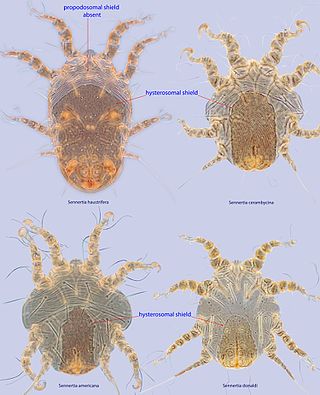
Sennertia is a genus of mites in the Chaetodactylidae family. There are more than 70 species. Some of these mites are parasites or commensals of bees, but the presence in some bees of specialized structures for carrying mites (acarinarium) indicates the mutualistic nature of the relationship of some species. Most species of the genus Sennertia settle on adult bees as heteromorphic deutonymphs, but the species Sennertia vaga has no deutonymph and settle on adult bees in the eating adult stages. Reproduction and feeding occurs during resettlement. Most species occur on small carpenter bees (Ceratina) and large carpenter bees (Xylocopa) of the family Apidae. A few species are associated with Centris (Paracentris) in the Neotropics.

Chaetodactylus krombeini was described by Karl Krombein and E. W. Baker in the 1960s. The mites are about 0.5 mm across, with the females larger than the males. Pollen mites are a kleptoparasitic pest of Megachilid solitary bees, with Ch. krombeini found with Osmia lignaria of North America,. Pollen mites do not feed on bees, but rather their provisions, and are harmful because they consume the food resources and starve or stunt the developing larvae; there is evidence that pollen mites also directly harm the egg by puncturing it.

Roubikia is a genus of bee-associated mites occurring in the neotropics. They are mutualists or commensals, and feed on fatty acids from floral oils and most likely on fungi. The type species is Chaetodactylus panamensis.
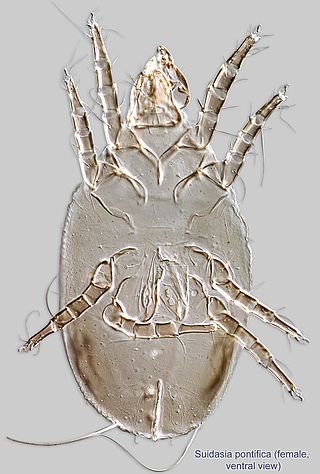
Suidasia is a genus of mites in the family Suidasiidae and clade Astigmatina.



















